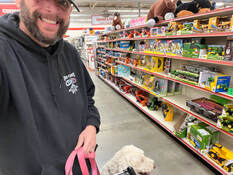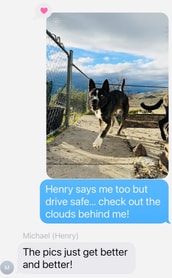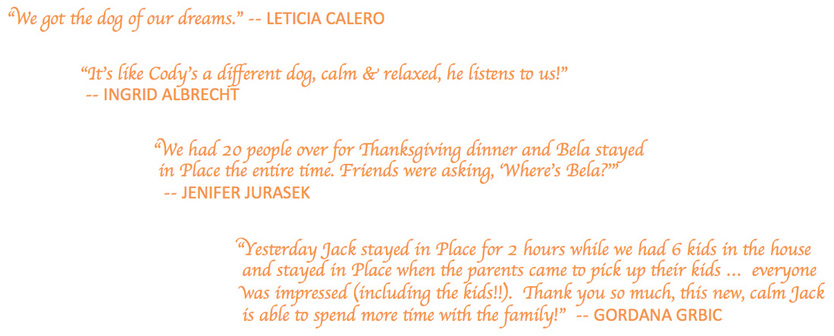Specializing in dog behavior rehabilitation for
aggression and reactivity.
The short road to a better dog.
During the board and train, the dogs develop strong impulse control and learn how to be calm around their triggers for reactivity or aggression. Additionally, their owners learn how to create a leadership relationship with their dogs. It's that new relationship that allows for sustained behavioral rehabilitation. Without it, the dogs will be fully rehabilitated with me but not with their owners. It's a critical element to success and a key focus of my work with my clients. I am proud of the long list who are living happily with their dogs years after their training with me. You can hear from them directly in the testimonial videos, linked on this page and under Testimonials.
Foundational Training:
Take Your Dog Anywhere
Calm, relaxed dog in your home and out in public
Off-leash recall (with distractions)
Polite to you and your guests
A pleasure to take on walks
Off-leash recall (with distractions)
Polite to you and your guests
A pleasure to take on walks
Schedule a free consultation today!
Email, Text, or Call
Email, Text, or Call
Behavioral Rehabilitation:
Any Breed. Any Size. Any Problem.
Dog Aggression
Human Aggression
Leash Reactivity (including redirection)
Red zone barking and lunging
Resource Guarding
Separation Anxiety
Human Aggression
Leash Reactivity (including redirection)
Red zone barking and lunging
Resource Guarding
Separation Anxiety
Schedule a free consultation today!
Email, Text, or Call
Email, Text, or Call
Testimonial Excerpts:
(One minute excerpts from owner interviews conducted years after training. Full interviews are available under the Testimonials tab.)
Arthur, highly reactive, unable to be walked by owners. Two years after training.
Frankie, reactive, dog & human aggressive. 14 months after training.
Hoshi, reactive, owners unable to take on walks, 8 months after training.
Bagel, dog & human reactive & aggressive, owner unable to take to work or include on camping trips, 8 months after training.
Owner Resources:
|
|
Watch these four clients talk about the before and after with their dogs. They describe their lasting results months and years after training!
|
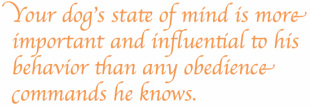
Beyond problem solving a specific behavioral issue, having a calm and relaxed dog allows you to spend more time with them, take them to more places, include them in more activities. At an outdoor cafe, he's lying relaxed under the table. On a hike or at the beach, he has the freedom to explore off-leash while you have the assurance he'll come to you when called. At home, he is polite and relaxed when company arrives.
My overarching goal is to improve your relationship with your dog. I'll do this by helping your dog change his default state of mind from quicksilver excitement to being calm and relaxed -- he'll have a greater capacity to "hear" you. And I'll also do this by helping you understand the small but impactful leadership techniques that get your dog not only to hear you, but to listen to you. Teaching your dog how to be calm is fundamentally the best thing you can do for his happiness and yours!
My overarching goal is to improve your relationship with your dog. I'll do this by helping your dog change his default state of mind from quicksilver excitement to being calm and relaxed -- he'll have a greater capacity to "hear" you. And I'll also do this by helping you understand the small but impactful leadership techniques that get your dog not only to hear you, but to listen to you. Teaching your dog how to be calm is fundamentally the best thing you can do for his happiness and yours!
|
|
Balanced Training, Balanced DogHaving a balanced dog means having a dog who listens to you. He doesn't (over) react to outside stimuli -- be it another dog, the doorbell, the mailman -- and generally behaves in a calm, respectful manner.
Balanced obedience training includes the same elements:
Taking a balanced approach to dog training includes focusing first on the dog's state of mind to teach him how to be calm and relaxed. A calm dog is less apt to react to stimuli making him more able to hear your commands. Balanced training incorporates a wide assortment of training tools and techniques finding the best fit for each dog. Please visit the FAQ page for more detail on my approach. |
New Skills
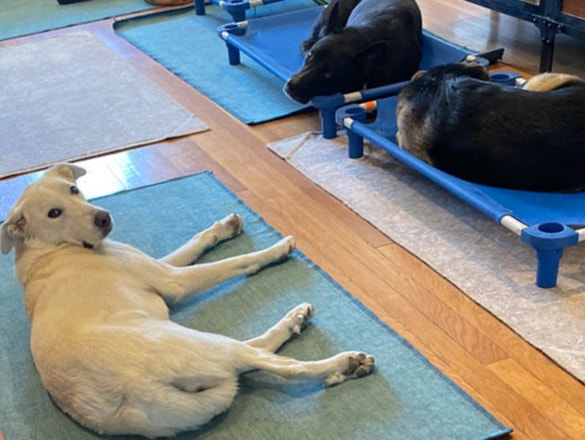
Your dog will learn new skills that are instrumental in supporting his behavioral rehabilitation. Often dogs with reactivity issues lack impulse control; when confronted with their triggers, they don't have the benefit of time to think before they act. Coupled with that is a tendency for them to have a high default excitement level. This means that when they do encounter a distraction, they are triggered to go over their tolerance threshold which brings on the explosion of barking and lunging. And finally, dogs with a history of aggression or reactivity are "stuck" with that approach because they haven't learned how to handle their discomfort with a healthier, more pro-social response, such as to walk away.
The underlying cause of your dog's behavioral challenges may stem from a few different issues and understanding your dog's specific temperament will be important as we work through his behavioral rehabiltiation. But what is common across all dogs, regardless of their underlying issue, is the importance of learning how to successfully handle the stimuli comes first. That's the first step. After repeated exposure to their old triggers where they are successful -- where they don't have an out-of-control reaction -- their confidence grows and the underlying issue ceases to be powerful. While that might sound too good to be true, realize that reaching that level of neutrality takes time. But until that moment happens, you and your dog will be able to encounter old triggers without the risk of the stressful and dangerous out-of-control reactions.
The underlying cause of your dog's behavioral challenges may stem from a few different issues and understanding your dog's specific temperament will be important as we work through his behavioral rehabiltiation. But what is common across all dogs, regardless of their underlying issue, is the importance of learning how to successfully handle the stimuli comes first. That's the first step. After repeated exposure to their old triggers where they are successful -- where they don't have an out-of-control reaction -- their confidence grows and the underlying issue ceases to be powerful. While that might sound too good to be true, realize that reaching that level of neutrality takes time. But until that moment happens, you and your dog will be able to encounter old triggers without the risk of the stressful and dangerous out-of-control reactions.
A Leadership Relationship
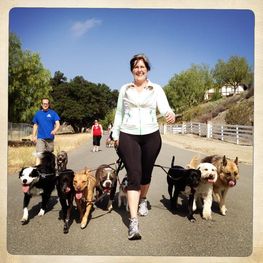
Struggling with your dog's behavioral issues is as tough on him as it is on you. What we sometimes don't realize is the level of anxiety and stress our dogs have been experiencing by the time they are displaying behaviors that get our attention.
For some dogs, receiving leadership from their owners is a necessary component to their well being. Different from giving food, shelter, affection and play, providing leadership is not intuitive for some owners. However, the positive effect can be seen almost immediately in those dogs who need it. Much like giving Vitamin C to a scurvy patient immediately rebalances their body chemistry, these dogs relax under the guidance and predictability of an environment with leadership.
For some dogs, receiving leadership from their owners is a necessary component to their well being. Different from giving food, shelter, affection and play, providing leadership is not intuitive for some owners. However, the positive effect can be seen almost immediately in those dogs who need it. Much like giving Vitamin C to a scurvy patient immediately rebalances their body chemistry, these dogs relax under the guidance and predictability of an environment with leadership.
It's Not Easy, But It Is Simple

Rehabilitating behavioral issues -- even the most dangerous -- is actually a straight forward process. The key is to start by building a strong foundation of rules and boundaries and only after that do you start to address the specific behavioral issues. It means a 2-3 week "upfront investment" which pays huge dividends over time. This approach reduces the size of the problem behavior, sometimes so drastically that the dog never has the same response to the trigger again. That's right, for some dogs, the strong foundation alone can resolve the behavioral issue. For other dogs, having the strong foundation in place makes the next steps of exposure to the triggers and learning healthy responses to them a much smoother and quicker process.
While this approach easily makes sense -- what in nature doesn't benefit from a strong foundation -- it is quite difficult in practice because intuitively we want to rush to address the problem. I believe one of my biggest values to my clients rests here: I provide them the structure and coaching to focus on the foundation first allowing them to suspend their disbelief long enough until the evidence speaks for itself.
I look forward to sharing what I learned with my dog Oliver during his journey to being a calm, relaxed and balanced dog. Even more, I am thrilled to share the knowledge I have gained since starting my professional work in 2013. My journey was longer than your dog's needs to be. Over the years I have honed my approach and fine tuned what's most critical to focus on based on your dog's temperament and your relationship with him, both as it stands today and with your future goals in mind. I look forward to sharing them with you so you can enjoy the short road to a better dog!
While this approach easily makes sense -- what in nature doesn't benefit from a strong foundation -- it is quite difficult in practice because intuitively we want to rush to address the problem. I believe one of my biggest values to my clients rests here: I provide them the structure and coaching to focus on the foundation first allowing them to suspend their disbelief long enough until the evidence speaks for itself.
I look forward to sharing what I learned with my dog Oliver during his journey to being a calm, relaxed and balanced dog. Even more, I am thrilled to share the knowledge I have gained since starting my professional work in 2013. My journey was longer than your dog's needs to be. Over the years I have honed my approach and fine tuned what's most critical to focus on based on your dog's temperament and your relationship with him, both as it stands today and with your future goals in mind. I look forward to sharing them with you so you can enjoy the short road to a better dog!

Visit the Reviews section of my Facebook page to read more client feedback.
